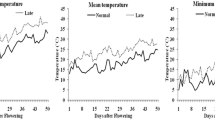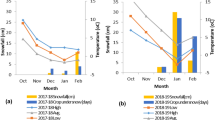Abstract
Economically important crop chickpea (Cicer arietinum L.) is sensitive to chilling stress, and breeding for chilling tolerance is the economic option even in countries with a high risk for drought and heat stresses. In this study, we have analyzed chilling-induced responses of ten chickpea accessions under field and growth-chamber conditions in order to screen, using phenotypic and physiological methods, for chilling tolerance. The field data analysis revealed that there were significant differences between accessions in their cold tolerance. The percent survival and cold-tolerance scores were the most important indices describing genotype tolerance to low temperature under field conditions; they can be used to assess chickpea cold tolerance. During environmentally controlled testing, the effects of low temperature regimes (−10°C for 15 and 30 min) were studied and cold tolerance was measured by electrolyte leakage from damaged leaves. The analysis of field data and cold treatments showed that two accessions, Sel 95Th1716 and Sel 96Th11439, grouped in one cluster, are good cold-tolerant genotypes (showing low scores for cold tolerance and electrolyte leakage). In comparison with ILC 8262, released as cold-tolerant accession, these genotypes showed more tolerance. Flip 00-6C, ILC 533, and Jam were less tolerant to cold stress. Thus, we have shown that as well as field studies, short-term cold treatment and electrolyte leakage assay can be used to evaluate low temperature tolerance of chickpea profitably in a short time.
Similar content being viewed by others

Abbreviations
- EL:
-
electrolyte leakage
- ELI:
-
electrolyte leakage index
- PCA:
-
principal component analysis
- UPGMA:
-
unweighted pair group method using arithmetic averages
References
Samach, A. and Wigge, P.A., Ambient Temperature Perception in Plants, Curr. Opin. Plant Biol., 2005, vol. 8, pp. 483–486.
Ishizaki-Nishizawa, O., Fujii, T., Azuma, M., Sekiguchi, K., Murata, N., Ohtani, T., and Toguri, T., Low-Temperature Resistance of Higher Plants Is Significantly Enhanced by a Nonspecific Cyanobacterial Desaturase, Nature Biotech., 1996, vol. 14, pp. 1003–1006.
Reddy, A.R., Chaitanya, K.V., and Vivekanandan, M., Drought Induced Responses of Photosynthesis and Antioxidant Metabolism in Higher Plants, J. Plant Physiol., 2004, vol. 161, pp. 1189–1202.
Hariadi, P. and Parkin, K.L., Chilling Induced Oxidative Stress in Cucumber Seedling, J. Plant Physiol., 1993, vol. 141, pp. 733–738.
Prasad, T.K., Anderson, M.D., Martin, B.A., and Stewart, C.R., Evidence for Chilling-Induced Oxidative Stress in Maize Seedlings and a Regulatory Role for Hydrogen Peroxide, Plant Cell, 1994, vol. 6, pp. 65–74.
Los, D.A. and Murata, N., Structure and Expression of Fatty Acid Desaturases, Biochim. Biophys. Acta, 1998, vol. 1394, pp. 3–15.
Thomson, G.A., Membrane Acclimation by Unicellular Organisms in Response to Temperature Change, J. Bioenerg. Biomembr., 1989, vol. 21, pp. 43–60.
Steponkus, P.L., Role of the Plasma Membrane in Freezing Injury and Cold Acclimation, Annu. Rev. Plant Physiol., 1984, vol. 35, p. 543–584.
Webb, M.S., Uemura, M., and Steponkus, P.L., A Comparison of Freezing Injury in Oat and Rye — Two Cereals at The Extremes of Freezing Tolerance, Plant Physiol., 1994, vol. 104, pp. 467–478.
Uemura, M., Joseph, R.A., and Steponkus, P.L., Cold Acclimation of Arabidopsis thaliana. Effect on Plasma Membrane Lipid Composition and Freeze-Induced Lesions, Plant Physiol., 1995, vol. 109, pp. 15–30.
Thomashow, M.F., Plant Cold Acclimation: Freezing Tolerance Genes and Regulatory Mechanisms, Annu. Rev. Plant Biol., 1999, vol. 50, pp. 571–599.
Xin, Z. and Browse, J., Cold Comfort Farm: The Acclimation of Plants to Freezing Temperatures, Plant, Cell Environ., 2000, vol. 23, pp. 893–902.
Maali Amiri, R., Goldenkova-Pavlova, I.V., Pchelkin, V.P., Tsydendambaev, V.D., Vereshchagin, A.G., Deryabin, A.N., Trunova, T.I., Los, D.A., and Nosov, A.M., Lipid Fatty Acid Composition of Potato Plants Transformed with the δ12-Desaturase Gene from Cyanobacterium, Russ. J. Plant Physiol., 2007, vol. 54, pp. 600–606.
Malhotra, R.S. and Saxena, M.C., Screening for Cold and Heat Tolerance in Cool-Season Food Legumes, Breeding for Stress Tolerance in Cool Seasons Food Legumes, Singh, K.B. and Saxena, M.C., Eds., Chichester: John Wiley and Sons, 1993, pp. 227–244.
Singh, K.B., Ocampo, B., and Robertson, L.D., Diversity for Abiotic and Biotic Stress Resistance in the Wild Annual Cicer Species, Genet. Resour. Crop Evol., 1998, vol. 45, pp. 9–17.
Mallikarjuna, Swamy, B.P., Upadhyaya, H.D., Kenchana, Goudar, P.V., Kullaiswamy, B.Y., and Singh, S., Phenotypic Variation for Agronomic Characteristics in a Groundnut Core Collection for Asia, Field Crop Res., 2003, vol. 84, pp. 359–371.
Hepburn, H.A., Naylor, R.E.L., and Stokes, D.T., Electrolyte Leakage from Winter Barley Tissue as Indicator of Winter Hardiness, Ann. Appl. Biol., 1986, vol. 108, p. 164–165.
Popov, V.N., Orlova, I.V., Kipaikina, N.V., Serebriiskaya, T.S., Merkulova, N.V., Nosov, A.M., Trunova, T.I., Tsydendambaev, V.D., and Los, D.A., The Effect of Tobacco Plant Transformation with a Gene for Acyl-Lipid δ9-Desaturase from Synechococcus vulcanus on Plant Chilling Tolerance, Russ. J. Plant Physiol., 2005, vol. 52, pp. 664–667.
Sneath, P.H.A. and Sokal, R.R., Numerical Taxonomy, San Francisco, USA: Freeman W.H., 1973.
Basu, P.S. and Singh, D.N., Physiology and Abiotic Stresses in Chickpea, Chickpea Research in India, Ali, M., Kumar, S., and Singh, N.B., Eds., Kanpur, India: Indian Institute of Pulses Research, 2003, pp. 137–166.
Yadav, S.S., Kumar, J., Yadav, S.K., Singh, S., Yadav, V.S., Turner, N.C., and Redden, R., Evaluation of Helicoverpa and Drought Resistance in Desi and Kabuli Chickpea, Plant Gen. Res., 2006, vol. 4, p. 198–203.
Orlova, I.V., Serebriiskaya, T.S., Popov, V., Merkulova, N., Nosov, A.M., Trunova, T.I., Tsydendambaev, V.D., and Los D.A. Transformation of Tobacco with a Gene for the Thermophilic Acyl-Lipid Desaturase Enhances the Chilling Tolerance of Plants, Plant Cell Physiol., 2003, vol. 44, pp. 447–450.
Sukumaran, N.P. and Weiser, C.J., An Excised Leaflet Test for Evaluation Potato Frost Tolerance, Hort-Science, 1972, vol. 7, p. 467–468.
Singh, K.B., Malhotra, R.S., and Saxena, M.C., Additional Sources of Tolerance to Cold in Cultivated and Wild Cicer Species, Crop Sci., 1995, vol. 35, pp. 1491–1497.
Author information
Authors and Affiliations
Corresponding author
Additional information
This text was submitted by the authors in English.
Rights and permissions
About this article
Cite this article
Heidarvand, L., Maali Amiri, R., Naghavi, M.R. et al. Physiological and morphological characteristics of chickpea accessions under low temperature stress. Russ J Plant Physiol 58, 157–163 (2011). https://doi.org/10.1134/S1021443711010080
Received:
Published:
Issue Date:
DOI: https://doi.org/10.1134/S1021443711010080



